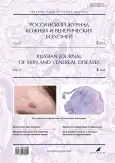Photogallery. Human papillomavirus infection of the skin and mucous membranes in people living with HIV
- Authors: Prozherin S.V.1
-
Affiliations:
- Sverdlovsk Regional Center for Prevention and Control of AIDS
- Issue: Vol 27, No 3 (2024)
- Pages: 366-372
- Section: PHOTO GALLERY
- Submitted: 14.02.2024
- Accepted: 12.06.2024
- Published: 04.07.2024
- URL: https://rjsvd.com/1560-9588/article/view/626917
- DOI: https://doi.org/10.17816/dv626917
- ID: 626917
Cite item
Abstract
The human papillomavirus is ubiquitous. It is estimated that over a third of people with apparently healthy skin are carriers of human papillomavirus. HIV-associated immunodeficiency contributes to the manifestation of clinical symptoms of human papillomavirus infection. Against the background of severe (the number of CD4+ T-lymphocytes below 200 cells/μl) and pronounced (CD4+ T-lymphocytes from 200 to 349 cells/μl) immunodeficiency caused by HIV infection (human immunodeficiency virus), the period of persistence of human papillomavirus is longer, and the clinical picture and course of human papillomavirus infection can significantly differ compared to HIV-positive individuals with intact immunity and people without HIV. At the same time, formations on the skin and mucous membranes are often multiple and can be characterized by rapid growth, large size, location outside the typical localization, resistance to treatment, recurrent course, and lack of tendency to spontaneous regression. Taking antiretroviral drugs for the treatment of HIV infection has a generally beneficial effect on the clinical course and prognosis of viral warts; With regard to anogenital warts, the researchers’ conclusions are not so clear. A number of experts believe that viral-immunological control of HIV infection may not be sufficient to successfully combat venereal warts.
The photogallery presents various clinical types of viral and anogenital (venereal) warts in people living with HIV. Each of them is assigned one of the variants of the stage of secondary diseases of HIV infection (4A, 4B or 4V according to its Russian clinical classification) depending on the severity of concomitant opportunistic diseases. In all clinical cases, with the exception of the last one, patients experienced severe or pronounced immunodeficiency and progression of HIV infection in the absence of antiretroviral therapy. In the last observation, giant Buschke–Levenstein condyloma developed with a slight immunodeficiency against the background of effective antiretroviral therapy.
Keywords
Full Text
About the authors
Sergey V. Prozherin
Sverdlovsk Regional Center for Prevention and Control of AIDS
Author for correspondence.
Email: progsherin@mail.ru
ORCID iD: 0000-0001-9956-4700
SPIN-code: 5354-4893
Russian Federation, Ekaterinburg
References
Supplementary files
















